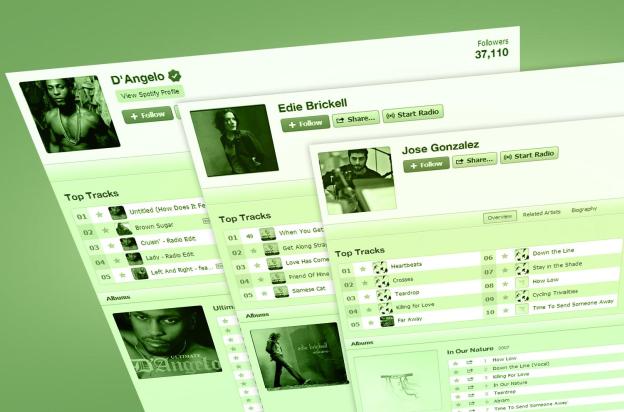
As a kid growing up during the hair-sprayed splendor of the 80’s, the mix tape’s importance in adolescent life could not be overstated. After all, when you’re young and the awkwardness of puberty is barely in your rear view mirror, learning how to express yourself to a romantic interest is a mountain that’s difficult to climb – or maybe it was just the parachute pants and Hypercolor shirt (I did mention this was the 80’s, right?). Back then, we used the best resource we had – a blank Maxell cassette tape with Edie Brickell and her New Bohemians explaining how we felt: “I’m not aware of too many things. I know what I know if you know what I mean…” Well, no, not really. But I felt like it made me seem deep, and seeming deep seemed important back then.
Such memories now resurface as I find myself addicted to Spotify’s new “follow” function. Plenty has already been written about Spotify, which is the best thing to come out of Sweden since the Saab and the meatball. Actually, scratch the last one. And, as a music service, Spotify has done pretty damn well for itself – it’s up to 6 million paying subscribers and 24 million total users. But as a business, the company is in a tricky spot, since reportedly 70 percent of its revenue goes to the hefty licensing fees that major music labels levy in exchange for unlimited streaming access to its content. According to a report on The Verge, the company spends another 20 percent of revenue on customer acquisition, which apparently leaves it with not enough money to topple iTunes or something. Hopefully they can figure it all out, because if we lost Spotify now, what we’d really lose is the first honest-to-God social network built around music.
Not only is Jose Gonzalez awesome, he’s Swedish! He’s like the Saab of Mexican-sounding singer songwriters!
By following my friends (the real ones, not the ones I accidentally accepted on Facebook four years ago and keep forgetting to de-friend) on Spotify, I’m able to see what playlists they’ve created, and who and what they’re listening to. The result is a weirdly intimate experience. For example, I see that my friend Steve’s Spring 2013 playlist includes a lot of D’Angelo and Miguel, so I know that Steve’s getting laid (the function is not yet powerful enough to confirm whether or not it’s with another person). My friend Debbie’s playing a lot of Morrissey, so I know Debbie is sad. See what you can learn? As Facebook has become a site where people attempt to present their best self – bragging about everything from European trips to delicious roast Tri-tips – Spotify has become a window to how my friends are actually doing.
But it doesn’t end there. Spotify allows me to follow my favorite artists now, too. When I do, I get their activity in my social feed alongside my friends. So now I know, for example, that D’Angelo is getting laid a lot and Morrisey is sad. And the artist pages have be redesigned to promote any playlists they create, since doing so now is basically the same thing as creating a mix tape for anyone who follows them.
Now, there are a lot of artists on Spotify, and very few of them are creating playlists, but some pretty big names are pretty active (or, at least, the 16-year-old nephews of some pretty big names are pretty active); Lou Reed has 19 playlists, Linkin Park’s Mike Shinoda has 13, and Lady Antebellum has 7. Turns out, Lou Reed’s nephew likes Jose Gonzalez! Have you heard of Jose Gonzalez? I hadn’t, until Lou Reed’s nephew showed him to me, and get this: not only is Jose Gonzalez awesome, he’s Swedish! He’s like the Saab of Mexican-sounding singer songwriters!
Following your favorite artists now means that you don’t just find new music by those artists, you find new music because of them. And it’s not limited to artists; if you like the music coverage by media brands like Rolling Stone or Complex, you can listen to what they’re writing about now because they’re curating playlists that mirror their coverage. I don’t follow Cat Fancy on Spotify, but I’m sure their playlists are just as adorable as their calendar.
This music-ification of social media is upon us (witness the new Myspace and Twitter #Music), and I couldn’t be happier – not just because I’m sick of looking at pictures of your kid on Facebook, but because now instead of using Edie Brickell to communicate my feelings, I can communicate with Edie Brickell herself. And you know what I would tell her if I actually had the balls to do that?
“’What I Am’ never got me laid even once. I’m switching to this D’Angelo guy.”




